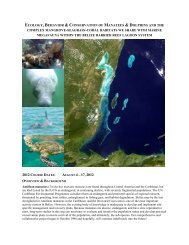PDF - Sirenian International
PDF - Sirenian International
PDF - Sirenian International
You also want an ePaper? Increase the reach of your titles
YUMPU automatically turns print PDFs into web optimized ePapers that Google loves.
5. To be an expert resource panel for the IUCN and other stakeholders.<br />
The group will focus on the following issues of concern:<br />
1. Red tide and episodic mass die-offs<br />
2. Habitat loss (seagrass and SAV degradation and loss)<br />
3. Coastal development<br />
4. Boat speed zones<br />
5. Harassment in sanctuaries<br />
-Dr. Christopher Marshall (marshallc@tamug.edu) and Dr. Graham Worthy<br />
(graham.worthy@ucf.edu)<br />
LETTER TO THE CITES SECRETARIAT FROM SIRENIAN SPECIALISTS<br />
February 7, 2013<br />
CITES Secretariat<br />
<strong>International</strong> Environment House<br />
11 Chemin des Anémones<br />
CH‐1219 Châtelaine, Geneva<br />
Switzerland<br />
Tel: +41‐(0)22‐917‐81‐39/40<br />
Fax: +41‐(0)22‐797‐34‐17<br />
Email: info@cites.org<br />
To whom it may concern<br />
As sirenian specialists, we would like to make the following points relevant to the proposal to list the<br />
West African Manatee on CITES Appendix I:<br />
Precautionary approach needed because of lack of robust information on population size and trends<br />
As the TRAFFIC advice indicates ‘no reliable population estimate exists, but there may be fewer than 10<br />
000 individuals and IUCN assessed the species as Vulnerable in 2008.’<br />
The population trend criterion (Criterion A) is usually the most appropriate IUCN criterion for<br />
evaluating the status of aquatic mammals. Estimating the population size and trends of West African<br />
manatees as required by the IUCN Red Listing process is very difficult. The species mostly occurs in<br />
turbid waters, surfaces cryptically and only for short periods, and can spend long but variable periods<br />
on the bottom. In addition, the probability of detecting West African manatees varies greatly with<br />
environmental conditions both among and within sites.<br />
These challenges are compounded for the West African manatee because it in developing<br />
countries which lack the resources required for expensive surveys. Thus there is no robust information<br />
about the population size and trends of West African manatees.<br />
High likelihood of IUU cross‐border trade despite lack of formal reports<br />
The TRAFFIC Advice indicates that current legislation in all range States prohibits trade in any<br />
part of the species and little international trade has been reported since the species was listed in<br />
Appendix II in 1975. Population models indicate that the status of sirenian populations is most<br />
affected by the mortality rates of adults. Hunting is the major source of anthropogenic mortality across<br />
Sirenews No. 59 4 April 2013













